![]() The Dell PowerEdge M I//O Aggregator is a slick blade switch that plugs into the Dell PowerEdge M1000e chassis and requires barely any configuration/networking knowledge. Think of it as an advanced layer 2 switch that provides expandable uplink connectivity. The base blade comes with 2 x 40 GbE ports that by default are configured as 8 x 10 GbE ports. If desired, these ports can also be used as 40 GbE stacking ports. The Dell PowerEdge M I/O Aggregator also provide 32 internal 10 GbE connections for Dell blade servers you can install in the Dell PowerEdge M1000e chassis. If quarter-height blade servers are used, the M1000e can support up to 32 servers. This is pretty cool, not only in terms of functionality, but also in terms of the consolidation and the mess of Ethernet/power cables avoided by not using standalone components.
The Dell PowerEdge M I//O Aggregator is a slick blade switch that plugs into the Dell PowerEdge M1000e chassis and requires barely any configuration/networking knowledge. Think of it as an advanced layer 2 switch that provides expandable uplink connectivity. The base blade comes with 2 x 40 GbE ports that by default are configured as 8 x 10 GbE ports. If desired, these ports can also be used as 40 GbE stacking ports. The Dell PowerEdge M I/O Aggregator also provide 32 internal 10 GbE connections for Dell blade servers you can install in the Dell PowerEdge M1000e chassis. If quarter-height blade servers are used, the M1000e can support up to 32 servers. This is pretty cool, not only in terms of functionality, but also in terms of the consolidation and the mess of Ethernet/power cables avoided by not using standalone components.
The I/O Aggregator is a great solution for those looking for a low-cost M1000e advanced L2 blade switch with hassle-free configuration and expandable upstream connectivity for Dell blade servers. It also has two Flex I/O expansion slots for additional modules. The currently available modules include a 2 x 40 GbE QSFP port module in 4 x 10 GbE mode, a 4 x 10 GbE SFP+ module, and a 4 x 10Gbase-T module. It’s important to note that these modules can be used together in any combination except (2) 4 x 10Gbase-T modules.
In this blog I’ll focus mostly on the Dell PowerEdge M I/O Aggregator and leave the detailed discussion of the Dell M1000e chassis for another blog. The goal of this blog is to demonstrate how easy it is to use Dell’s I/O Aggregator
blade switch with both Dell Force10 switches and other vendors’ switches. For this lab I use Dell PowerEdge M I/O Aggregator [FTOS 8.3.17.0], Dell Force10 S4810 [FTOS 8.3.7.0], and Cisco Nexus 5548UP [NX-OS 5.1(3)N2(1)].First, I will demonstrate connecting the I/O Aggregator blade switch to a ToR Dell Force10 S4810 switch. Below is the lab diagram for this setup. Note that I use (2) 40 GbE to 4 x 10 GbE Twinax breakout cables to connect the two 40 GbE QSFP ports on the I/O Aggregator to eight 10 GbE ports on the S4810. Interestingly, I was able to put an IP address on the default VLAN (VLAN 1) of the I/O Aggregator. This will allow me to test my connectivity from the S4810 to the I/O Aggregator without having to setup and ping a server.
[Dell I/O Aggregator Configuration] | [Dell Force10 S4810 Configuration]
Note, all I have done is connect the 40 GbE to 4 x 10 GbE Twinax breakout cables from the I/O Aggregator blade switch to the S4810 switch. I do not need to do any configuration on the I/O Aggregator blade switch; I put an IP address on VLAN 1 via the CLI for testing purposes only. The I/O Aggregator simply puts all eight 10 GbE uplink ports in one LACP port-channel (port-channel 128). Additional ports can be added via the expansion slots to provide additional bandwidth. It is important to note that since the uplink connectivity is automatically bundled into one port-channel, no spanning tree protocol (STP) is required or used. Typically, if any minimal configuration is needed on the I/O Aggregator, it would be done via the Chassis Management Controller (CMC) web interface which even a server admin could have access to.
The only configuration that is required at this point is on the S4810 ToR switch as shown below. Once configured, you can see we have no problem pinging the I/O Aggregator.
Note, by default, on the I/O Aggregator, port-channel 1 is a hybrid port and is untagged on VLAN 1 and tagged on every other vlan on the switch. You can see this below from the partial snapshot of the ‘show vlan’ command on the I/O Aggregator.
Now, we’re going to change the lab setup slightly to show how easy it is to use I/O Aggregator with other vendors’ switches. Below is our new lab setup. As you can see, we now have the I/O Aggregator connecting to a Cisco Nexus 5548UP switch. Since I only have the default L2 software purchased on the Nexus 5548UP switch, I also connect it to a Dell Force10 S4810 switch in order to test connectivity via ping.
[Cisco Nexus 5548UP configuration]
Since I am using Dell Force10 40 GbE to 4 x 10 GbE Twinax breakout cables, the first thing I need to configure on the Cisco Nexus 5548UP is the ‘service unsupported-transceiver’ command in ‘config’ mode as shown below. This command is needed to support non-Cisco optics.
Next, I configure the Cisco Nexus 5548UP as shown below.
Since I am also connecting to the Dell Force10 S4810 so I can test connectivity through the Nexus 5548UP, I configure the S4810 as shown below.
Below I show that I am able to ping the S4810 from the I/O Aggregator and through the Cisco Nexus 5548UP. Again, no configuration is required on the I/O Aggregator. I simply put an IP address on VLAN 1 below for testing purposes.
On the I/O Aggregator, if I try to configure an IP address on any other vlan, I get the below message.
As you can see, the Dell PowerEdge I/O Aggregator offers a simple but powerful solution for upstream connectivity for the Dell PowerEdge M1000e chassis. In addition, the I/O Aggregator is configured by default to work with iSCSI and FCoE devices. The I/O Aggregator comes preconfigured with DCB, jumbo frames (MTU = 12000 bytes) and storm control (broadcast, multicast, and unknown unicast); you can see this via the full Dell I/O Aggregator configuration link provided prior in this blog.

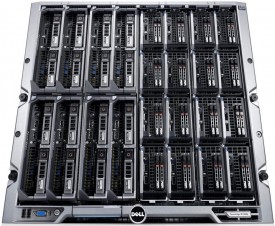
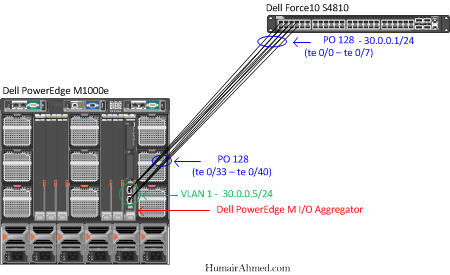

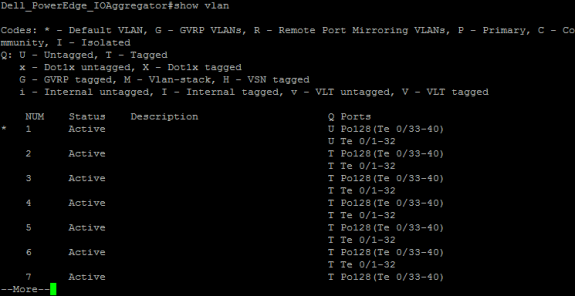
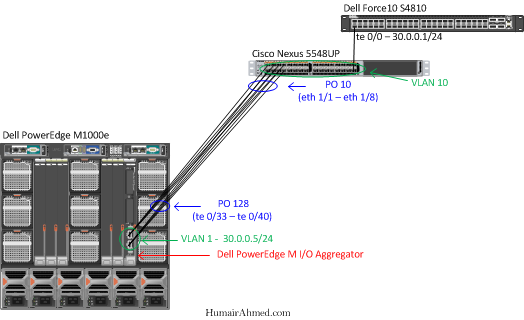
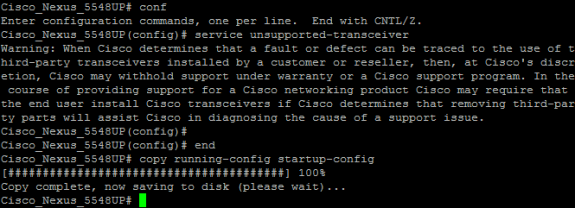
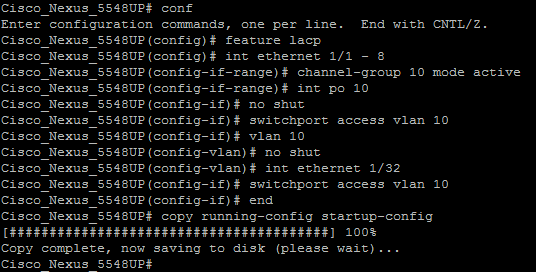

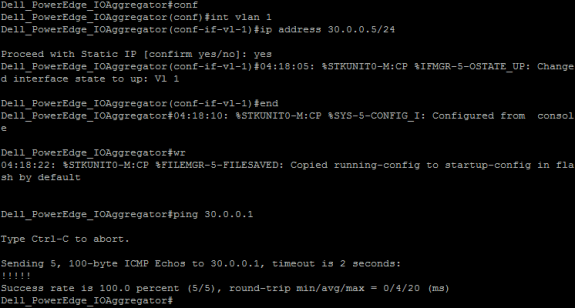



 Twitter
Twitter LinkedIn
LinkedIn Youtube
Youtube RSS
RSS
2 Responses to Connecting Dell PowerEdge M I/O Aggregator with Dell Force10 S4810 and Cisco Nexus 5548UP